
Surveyors require a wide range of complex equipment to take accurate measurements of land. If you’re working as a surveyor, or considering training to become one, use this guide to compare key surveying equipment options. From magnetic locators to tripod stands, find must-have tools to make accurate measurements and perform other essential surveying duties.

How To Choose Survey Equipment
There are many different types of survey equipment available, so it can feel overwhelming shopping for the first time. Don’t let the complexity of different items overwhelm you. A professional surveyor should be familiar with all of these types of equipment, but you don’t need to understand every item if you’re just getting started or measuring distances for construction purposes.
Start by reviewing the most common surveying tools available for your role as a surveyor, architect or other professional. It’s important to understand the purpose of common surveying items before you make your first purchase. Here are some key ones you should be familiar with:
- Magnetic locators
- Total stations
- Theodolites
- Tripods
- Transit levels
- Auto levels
- Range poles
- Survey prisms
Consider the best brands and styles of these items to prepare for the most common surveying tasks. Use this guide to weigh the pros and cons of highly rated options before making a purchase to replace a damaged tool or expand your surveying toolkit.
It pays to choose a name-brand item. Surveying is a very precise skillset, so you need a range of precision instruments to accurately mark lot lines, create quality landscaping or prepare a building site.
Magnetic Locators
If you’re looking for lot lines in an urban or suburban area, there are likely already surveying stakes in the corners of every lot. It’s important to mark your own lines to verify accuracy, but a convenient place to start is with the existing surveying stakes.
A magnetic locator helps you find these stakes. Simply turn on the locator and work your way around the area where a stake is likely buried. These locators detect magnetic signals from buried metal items, so they’ll find a number of other items in addition to surveying stakes. Once you find a metallic object, dig it out to verify it’s a stake.
One of the most convenient, practical locators is the
Schonstedt GA-52Cx. This basic model is highly reliable, but doesn’t have all the programmable settings of other locators. Use it to find metallic objects with highly sensitive location technology and a rugged, weather-resistant control panel.

The
Pipehorn 800HL detector is one of the most versatile options for locating buried objects. This dual-frequency detector works as both a pipe and cable locator. Connect the transmitter to a buried line to follow an electric, water or gas line buried in the ground. Once you locate and flag these buried lines, switch modes to sweep for unmarked utilities with the tracer wire and tape.

A more portable, high-tech Schonstedt magnetic locator option is the
GA-92XTd. This model uses a compact design and versatile control panel for both audio and visual indication. The small size doesn’t mean less power, so you can use this locator to find ferrous items buried up to 16 feet underground. Pack it away in the small, durable case to keep in your truck or toolbag wherever you work.

Total Stations
In the past, surveyors carried theodolites, transit levels and electronic distance meters. All of these separate items were necessary, but created a bulky toolkit. Total stations combine all three of these essential surveying items into a single, high-tech device. Choose a precision total station and a durable tripod to perform essential angle and distance measurements of small or large projects.
The
Leica iCON iCB70 is a digital station with mobile data capabilities and tight tolerances. This convenient device makes it easy to create layout points and perform other essential duties with little training. The included software helps you transfer data for construction projects and see fully rendered models of your measurements.

While most total stations use digital features, the latest innovation in the industry is in robotics. The
GeoMax Zoom90 robotic total station takes on many of the tedious processes for a more automated, hands-off system. Streamline scans, measurements and other surveying functions with this compact, highly capable device. It’s fully connected and can take measurements up to 1000 meters using reflectorless measurement technology.

Another popular Leica option is the
iCON iCB50. Similar to the iCB70, this 5-second manual construction total station boasts a compact size, convenient functions and easy controls. It uses quadruple axis compensation for improved accuracy and has a resolving power of 3 inches.

Theodolites
One of the oldest and most essential pieces of surveying equipment is a theodolite. This reliable optical device measures both horizontal and vertical planes. It’s used to perform calculations and identify distances without the use of tape or rope. A total station comes equipped with a theodolite, but there are situations where it may be more convenient to have one of these devices separate from your all-in-one device.
Consider the
Topcon DT-307L theodolite for absolute circle reading technology. This weather-resistant device uses a laser and a lightweight design to give you accurate readings up to 165 feet. A 7-second accuracy and 45 hours of operating time while using the laser ensure this theodolite will be ready for plenty of demanding surveying projects.

The
Leica LDT-05 digital electronic theodolite also uses a compact size that doesn’t compromise on measuring accuracy. This 5-second theodolite has a laser plummet and can easily measure all four right angles with a quick orientation design. The dual backlit LCD screen is packed with features to help you take on complex tasks without using a total station.
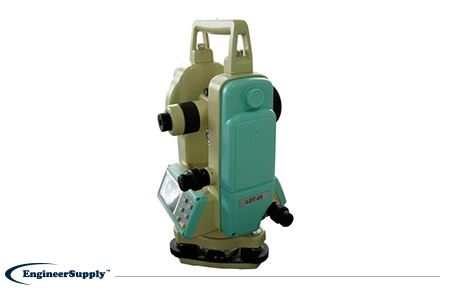
Another convenient 5-second digital theodolite to consider is the
Futtura DT-5. It costs less than many 9-second theodolites and has a removable tribrach. Choose from a range of flexible mounting options before using the optical plummet to easily set up your device and take measurements.
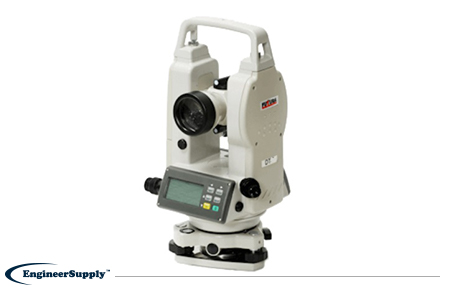
Survey Tripods
One of the most overlooked survey supplies is the tripod. While a tripod may not have state-of-the-art features or a convenient LCD screen, it does keep your total station, laser scanner or theodolite safely supported as you perform your essential duties. Compare tripod size and features to find one that fits your toolkit and your surveying devices.
The type of tripod you choose depends on the equipment you have. Many tripods have a universal flat head design, but some are specifically tailored to laser scanners, total stations or other devices. Consider the equipment you use regularly and your height requirements as you look for an affordable, durable tripod for your surveying needs.
A popular tripod to consider is the
Nedo 210710. This Industrial Line elevating tripod is designed for 3D laser scanners. It boasts a toothed column, magnetic bit holder and durable leg struts. Choose it to enjoy a maximum effective height of approximately 197 inches.

Seco offers a Tri-Max quick clamp tripod, the 90550. Fast, efficient and effective, the Tri-Max line offers incredible stability and convenient use. Extensible legs and a flat top head makes it easy to set up and install your device. Perform your essential duties before quickly folding it back up and moving on to the next project.

Choose the
Bosch BT160 Contractors Tripod for a lightweight and long-lasting piece of equipment. The aluminum frame and quick-clamp design gives you plenty of great features, and the affordable price tag makes it a great back-up tripod or budget-friendly solution. Consider this option if you need a flat tripod head and up to 63 inches of height without investing a significant amount.

Transit Levels
Find the true horizontal line and measure angles of inclination with a transit level. This flexible tool is often used in surveying for construction purposes, but can be used for a range of tasks. Combine it with a calibrated rod to find the degrees, minutes and seconds of inclination from a true horizontal line.
Whether you’re preparing to lay a foundation or creating a gentle landscaping slope, this tool is essential for any surveyor. It’s included in a total station, but some projects are better served with a separate transit level and other devices. Compare working ranges, movement styles and grad rods to find a transit level that fits your typical landscaping or surveying projects.
One competitive option for your toolkit is the
David White LT8-300P. This 26x transit level uses an optical plummet, horizontal circle and vertical arc. At 150 feet, the leveling accuracy is plus or minus 3/16 inch. A rain hood keeps the instrument protected as you make adjustments and take measurements in inclimate weather.
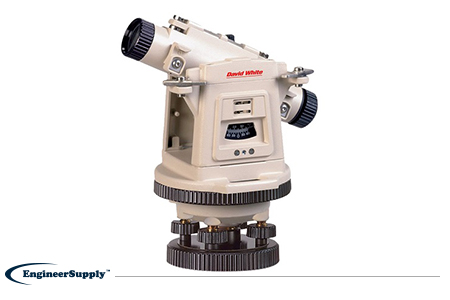
Northwest Instrument offers the NSLP500B package for all-in-one transit level convenience. Not only does it come with a reliable level capable of operating at 200 feet, it also includes a tripod, grad rob, plumb bob and carrying case. Focus on the grade rod from 3.5 to 200 feet and easily measure the angle for landscaping or construction purposes.

Pick up another popular David White transit level, the
LT8-300LTU-LP, for convenient alignment control. This transit level boasts 360 degrees of telescope rotation. Unlike the LT8-300P, this level can be directed to angles directly below the instrument for taking measurements as you prepare to lay pipe.
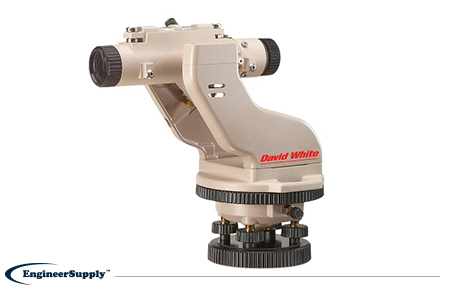
Auto Levels
Looking for a quick level line in your surveying or building project? An auto level performs this specific task quicker and easier than other devices. They can be more affordable than transit levels and other leveling and angle-taking options.
Look for an auto level with a built-in compensator and tight tolerances. You shouldn’t have to spend a lot of time setting up your auto level or comparing results to verify accuracy. Some come with their own tripod, while others require a separate tripod.
Pick up a
Topcon AT-B2 for a 32x magnification automatic level with 1/32 inch accuracy. A focus range of 7.9 inches and a two-speed focusing knob give you convenient and accurate readings with excellent magnification.

While the AT-B2 offers plenty of convenient features, the
Sokkia B20 is another competitive 32x magnification level. This impressive auto level has a retractable lens hood, peep sight and two-speed focusing knob. Just like the AT-B2, this model is capable of focusing on distances just 7.9 inches from the end of the telescope. A single screw makes reticle adjustments a breeze, and a pentaprism mirror offers high-quality readings.
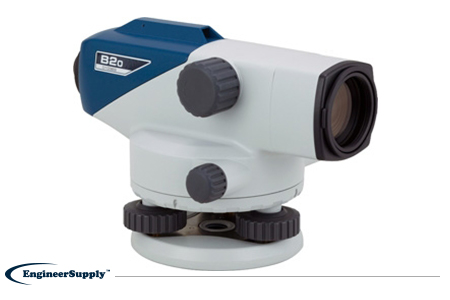
Bosch offers a much more affordable auto level option with the 26x magnification
GOL26. A self-leveling compensator makes it easy to quickly set up and take measurements. The lens doesn’t have the same levels of magnification, but this reliable auto level can still be used for applications up to 330 feet. Choose this level for a cost-effective way to take quick measurements.

Range Poles
Mark your survey station position with a highly visible range pole. These durable rods are convenient for marking long survey distances as you stake out property boundaries. The bright color and durable material of these poles make them popular choices for outdoor applications. Stake out a line with confidence when you combine range poles with other high-quality surveying tools.
A range pole that’s under 12 feet is called a range rod. Both rods and poles are useful for different applications. Rods are more portable and easy to set up, but range poles offer greater visibility and less risk of being lost in the grass or debris at a job site.
Nedo offers sectional steel range poles that are attachable for custom lengths. This pack of 12 poles can be connected to make extra-long poles, or kept separate for multiple marking points. They’re protected by a one year manufacturer’s warranty and are painted with luminous lacquering for a high-visibility red and white design.

Choose the 3.6-meter composite pole by
SitePro for a non-conductive fiberglass alternative. This durable pole comes in three sections for convenient storage. Red-and-white striping helps keep the pole visible and helps it fit in with your other range poles.

For a unique range pole design, consider the
Seco Rover Rod. This three-position snap-lock pole uses an aluminum construction and one-piece design for durable use. Rather than the traditional red-and-white coloring, this pole uses external graduations for ease of measurement. The entire pole weighs just 2.34 pounds and is easy to set up and secure.

Surveying Prisms
The electronic distance measurement beam projected by your total station needs an optical surveying prism to reflect back to your total station. These two devices combine to offer accurate distance measurements without using a tape measure or cord. Surveying prisms are commonly used for the following types of monitoring:
- Deformation
- Settlement
- Rail
- Convergence
- Displacement
To install a surveying prism, be sure it’s secured to a rigid structure and is shielded from radiant heat and high temperatures. Make sure it has a clear sight line with your total station. Even mesh or fencing can affect sight lines.
Compare the
Leica GPR121 Circular Prism with other options to see how this competitive prism rates. It uses a durable holder and high-quality metal components for a long-lasting design. The high-visibility arrows around the prism make it easy to see from a distance as you line up your total station to take measurements.

Seco offers a 62 millimeter standard prism assembly in another highly visible design. Choose a fluorescent orange, fluorescent yellow or standard yellow background to easily see your prism from the required distance. The powder-painted aluminum tilting holder and the waterproof canister-type prism are capable of withstanding years of outdoor use.

For an affordable alternative to pair with your total station, consider the
SitePro Single Prism Assembly. This design uses a metal yoke and polycarbonate assembly to balance durability and affordability. It’s capable of tilting a full 360 degrees and the precision glass is capable of up to 2 arc seconds of accuracy.

Find Your Survey Equipment at Engineer Supply
Whether you need to replace a single tripod or you’re looking for an entire surveying setup, turn to Engineer Supply. Shop for survey equipment today to deliver professional equipment directly to your door.

Frequently Asked Questions
What Is the Most Important Tool in Surveying?

Surveyors must use a range of tools to accurately measure land. A GPS is an essential tool for surveying, but surveyors must also use magnetic locators, total stations, theodolites and other equipment to perform their role. The exact toolkit can vary depending on the scope of the project.
What Is Modern Surveying Equipment?
Digital levels, theodolites, total stations, prisms and magnetic locators are just a few modern pieces of land surveying equipment. A total station is perhaps one of the most important. It’s mounted on a tripod and sends a signal to a prism for accurate, convenient land surveying.
What Is a Surveying Machine Called?
While there are many types of equipment used in surveying, the most common surveying machine is a total station. This versatile machine combines a theodolite and distance meter in a fully electronic setup. It measures angles with a movable telescope and can measure vertical and horizontal planes for convenient measurements.
How Do Surveyors Measure Land?
Modern surveyors use state-of-the-art equipment to measure distances and angles. The exact equipment varies depending on the distances being measured and the accuracy required. Surveyors determine property lines and other important land features before land is sold or a building project starts. Surveyors need both high-tech equipment and specialized skills to perform their role.
Is Land Surveying a Good Career?
Consider a career as a surveyor for a competitive salary and an opportunity to work outdoors. Many surveyors enjoy being able to work outdoors without working in a physically demanding role. Surveying is a highly sought after career with the ability to have a flexible schedule and work locally or nationally.